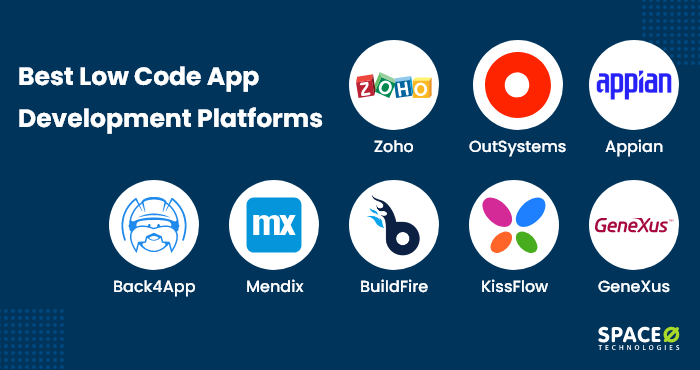Benefits Of Low-Code Application Development Terms Of Speed
Visual Development Environment (VDE):
Drag-and-Drop Interfaces: Low-code platforms provide visual tools for designing applications. Developers can utilize drag-and-drop tools to quickly assemble applications without writing a large amount of code.
Pre-built Components and Templates: Numerous platforms that can offer low-code support include components and pre-built template, allowing developers to prototype quickly and develop applications without starting completely from scratch.
Reduction of Coding Requirements
Automated code generation: Low-code systems generate the codes that are used to build them based on visual models created and maintained by programmers. This eliminates the need to manually code and speeds up development.
Reusable Parts: Developers will have the ability to reuse reusable components across different projects, and cut down on the time needed for writing and testing code.
Streamlined Collaboration:
Low-code development platforms are typically equipped with tools like deployment control, version control and testing. This allows seamless collaboration between teams.
Development by citizens: Using intuitive interfaces and reducing bottlenecks that are often caused by limited availability of developers, business users and non-developers are able to assist in application development.
Rapid Iteration and Prototyping:
Rapid Prototyping Developers can swiftly create prototypes of ideas that can be tested and feedback to be gathered, resulting to faster iteration.
Easy Modifications: The visual design of low-code programming makes it simpler to make modifications and updates to applications, which accelerates the process of improving and refining applications based on feedback from users.
Pre-built Integrations:
API Integrations: Platforms that are low-code usually include pre-built connectors to well-known APIs and services making it easier to connect external systems.
Data Integration: Inbuilt instruments for data integration make it easier to process of connecting to databases and other sources of data and speeding development.
Deployment Scaling
One-Click Deployment: A lot of low-code platforms have one-click deployment, greatly reducing the time and effort required to deploy software.
Cloud-Based Solutions: Cloud-based, low-code platforms are able to manage infrastructure and scaling which allows developers to concentrate on the logic of their applications and functions rather than the logistics of deployment.
Overall, the benefit of developing low-code applications in terms of speed is in its ability to streamline and automate various aspects of the development process. This allows rapid delivery of apps and quicker adaptation to changing requirements. Take a look at the recommended recommended site about Low-code Platform for application development for site info including application modernisation, app development platform, no code platforms, azure sql server, multiplatform mobile app development, cross platform mobile app development, low code platforms, rad application development, rad development, application development platforms and more.

Benefits Of Low-Code Application Development In Terms Of Scalability And Flexibility
Low-code development can bring many benefits in regards to scalability and flexibility essential to creating applications that are capable of growing and adapting to changing business needs. Here are the major advantages:
Cloud-based deployment: Many low-code platforms use cloud technology which allows applications to grow effortlessly with the cloud infrastructure. It allows businesses to manage more workloads without having to worry about managing servers.
Auto-Scaling: This feature can automatically adjust the resources in accordance with the demands. This ensures constant performance during peak times with no manual intervention.
Flexible Architecture:
Low-code platforms facilitate modular design, allowing components to independently developed, evaluated and scaled. Modularity increases flexibility, and it's easier to update specific parts of an application without having to affect the entire system.
Microservices integration: The ability to support microservices architecture allows applications to be developed as a collection loosely connected services. This improves capacity and flexibility.
Customizable Solutions:
Extensibility. Low-code platforms typically allow the creation of custom scripts or coding. This allows developers to enhance the capabilities of the software beyond the capabilities it offers from the box. This ensures that unique business needs can be fulfilled without a limit.
Third-Party Integrations: Integration with third-party APIs or services allows companies to add more functionality to their software.
Agile Development Deployment, Agile Development Agile Development:
Continuous Deployment and Delivery: Low code platforms support agile processes, allowing continuous deployment and integration (CI/CD). This allows applications to be upgraded and upgraded swiftly and in response to feedback from users.
Iterative Development: Because of the iterative nature low-code programs can scale and improve gradually. This reduces the potential risk of major changes and allows for greater control over expansion.
Resource Optimization
Effective resource management: Low code platforms optimize resources by offering tools for monitoring and controlling application performance. This ensures that resources are efficiently used and can be scalable either up or down depending on actual needs.
Load Balance: This function allows the application to handle massive traffic by distributing workloads over several servers. It also ensures the application's performance is constant.
Global Reach
Multi-Region Availability: Lowcode platforms allow to be used across a variety of regions. Businesses can offer users low-latency worldwide access. This is crucial when it comes to applications that target an international audience.
Localization Support for localization integrated into the software, allowing applications to be modified to accommodate various languages or regional needs. This enhances flexibility for diverse markets.
Updates and maintenance:
Maintenance is simplified by the visual nature and modularity of low-code apps makes maintenance simpler, allowing for quick fixes and updates to be implemented without lengthy downtime.
Version Control: A fully integrated version control system helps keep track of changes and rollbacks. This means that updates are easily installed and older versions can be restored if needed.
Cost Efficiency:
Low Development Costs - Through reducing the amount of coding needed, low-code platforms can lower development costs. This makes it possible to scale up applications without having to increase development efforts and expenses.
Pay-As you Go Models: Many platforms for low-code users offer a variety of pricing options, such a pay-as-you go model that aligns the cost and usage to actual growth.
Low-code development provides businesses with numerous advantages, such as scalability, flexibility and adaptability. This lets them create robust, adaptable and scalable applications. These platforms provide quick responses to evolving requirements, resource efficiency, and continual improvements, making it possible for applications to grow as a company. See the most popular he said for Legacy application modernization with Low-code for more examples including cross platform mobile dev, azure sql databases, driver jdbc, lowcode no code, rapid application design, rad development, cross platform mobile development, paas service, app dev platform, app modernization and more.

Vendor Support And Community Are Two Advantages Of Low Code Development For Applications.
Low-code development platforms for applications are a great method to gain vendor support and community participation. Both of these factors are vital for ensuring an effective implementation and continuous maintenance of the app. Support from the Vendor
Comprehensive Technical Support:
Support Teams Dedicated to You: A lot of low-code platforms have access to support teams that can assist with technical issues, troubleshooting, and help, making sure that all issues are solved promptly.
Some vendors provide 24/7 support. This is useful for companies that operate across time zones.
Training and Onboarding
The structured training programs offered by vendors provide structured courses such as webinars or certification courses. This allows users to quickly grasp the platform.
Personalized Onboarding: Many vendors offer personalized onboarding to assist new customers implement the platform in a way that is effective and customize it to meet their needs.
Updates and Enhancements, Regularly and Enhancements:
Continuous Improvements: Low-code vendors regularly release updates with improvements in performance, new features and security patches to ensure that the platform is up-to-date.
Feedback Integration Vendors incorporate customer feedback into the development process to ensure that the platform evolves in response to the changing requirements.
Comprehensive Documentation:
Documentation is detailed: Users are usually able to access extensive and well-organized documents, which range in complexity from basic customization to advanced.
API References API documentation offers detailed API references to assist developers connect their low-code platform apps with other platforms.
Professional Consulting Services
Expert Consulting: Many firms offer consulting services that help users with complex implementations and designs for architecture, as well as strategic planning.
Custom Development Services Some vendors offer customized development services for specific features or integrations not available in the box.
Community Support
Active User Groups:
Discussion boards and forums A lot of platforms with low-code have vibrant online community that allows users to seek help, share solutions, and work together to discover the best techniques.
Local and virtual User Groups These groups give you the chance to meet, network, and share your experiences.
Knowledge Sharing and Collaboration:
Community-Contributed Resources: Users often share templates, modules, and extensions that they have developed, which can be reused or adapted by others, accelerating development and innovation.
Crowdsourced problem solving The collective experience and expertise of the community can be an invaluable resource for troubleshooting problems and generating creative solutions.
Learning and Development
Community-led Training: A lot of groups organize workshops, training sessions, and webinars. They are usually conducted by experts in the field, who share practical knowledge and advanced techniques.
Tutorials and Online Courses: Community members frequently make and share online courses, tutorials, and how-to guides, enhancing the learning resources accessible to all users.
Feedback and Influence
Product Feedback Channels Community forums offer a variety of channels for providing feedback to vendors. This can help shape the development of features.
Beta Testing: Members of active communities might be eligible to take part. This gives them early access and to be involved in the design of the platform.
Recognition and Support
Community Recognition Programs: Many vendors offer recognition programs to recognize the contribution of community members who are active for example, MVP (Most Valuable Professional) programs.
Peer Support : Community members give support to each other, sharing their experience and offering guidance. They create a collaborative and supportive atmosphere by sharing knowledge.
Overall the combination of strong support from the vendor and an active, engaged community provides an entire support network for the development of low-code applications. The combination of robust vendor support and an active and engaged community creates an entire support network for low-code application development.

Comments on “Great Ideas On Deciding On Legacy application modernization with Low-code”